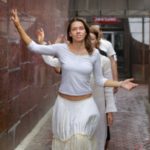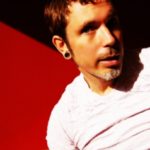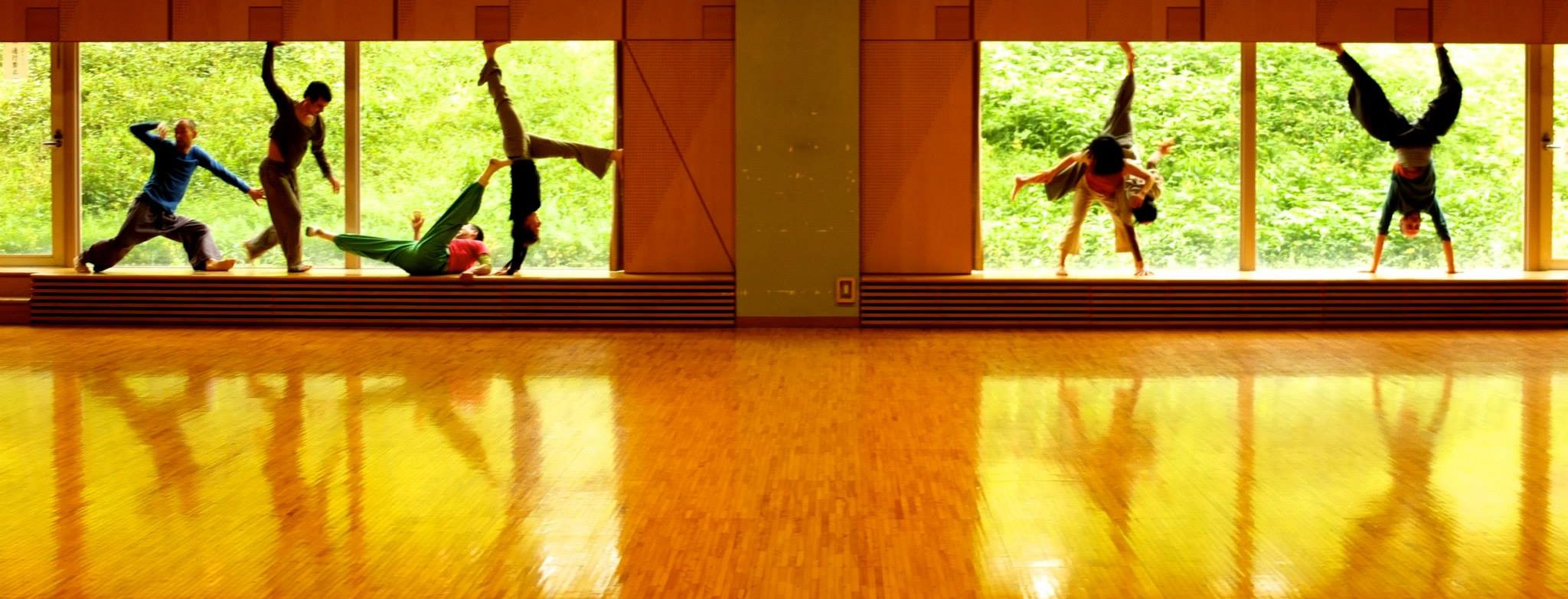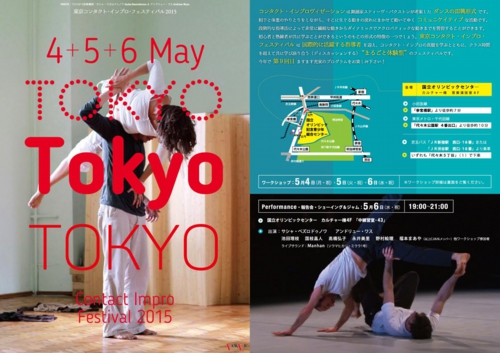| 5月4日 | 5月5日 | 5月6日 |
| 中練習室・#42 | 中練習室・#43 | 中練習室・#42 |
| 受付・ミーティング recepion/meeting9:00〜 |
フリースペース free9:00〜 |
フリースペース free9:00〜 |
| CI-A 1
10:00~12:15 |
CI-A 2
10:00~12:15 |
CI-A 3
10:00~12:15 |
| CI-B 1
13:30~15:45 |
CI-B 2
13:30~15:45 |
CI-B 3
13:30~15:45 |
| BMC
16:00~18:15 |
BMC
16:00〜18:15 |
クロージング closing16:00~16:30 |
| JAM
19:30~21:30 |
JAM
19:30~21:30 |
#43 報告会 report meeting showing&JAM19:00〜21:00 |
CI-Aクラス
サシャ・ベズロドゥノワ (ロシア)
Sasha Bezrodnova
 モスクワ市立教育心理学大学(MGPPU)で社会心理学、ビジネス・トレーナー、組織開発を学ぶ。彼女がCIの指導で大きな影響を受けたと挙げる舞踊家には、A.ドニ、N.S.スミス、D.レプコフ、N.リトルらがいる。現在、モスクワのプラクティカ劇場で定期クラスをもつ他、ロシア、ウクライナ、エストニア、ギリシャ、イスラエル、アルゼンチン、ブラジル、パレスチナ、ジョージア、ポルトガルなど様々な都市で、大人や親子、心理学者を対象にジャムやクラス、ワークショップなど指導者として幅広く活躍している。
モスクワ市立教育心理学大学(MGPPU)で社会心理学、ビジネス・トレーナー、組織開発を学ぶ。彼女がCIの指導で大きな影響を受けたと挙げる舞踊家には、A.ドニ、N.S.スミス、D.レプコフ、N.リトルらがいる。現在、モスクワのプラクティカ劇場で定期クラスをもつ他、ロシア、ウクライナ、エストニア、ギリシャ、イスラエル、アルゼンチン、ブラジル、パレスチナ、ジョージア、ポルトガルなど様々な都市で、大人や親子、心理学者を対象にジャムやクラス、ワークショップなど指導者として幅広く活躍している。
またパフォーマーとして、S.バッツ、K.フロスト、K.ミコス、A.ガーション、A.アンドリアノフ、T.バルナシュフなど様々なアーティストのプロジェクトに参加。自身も多くのフェスティバルの企画に携わり、モスクワのCI&パフォーマンス・フェスティバル(www.contactfestival.ru)やロシア最大の湖ラドガ湖で毎年行われるCI野外フェスティバル(ww.ladoga-dance.ru)、タイのCI&ウォーター・ダンスフェスティバル(www.ci-thai.com)、エジプトの アンダーウォーター・ダンス・プロジェクト(www.freediver.me)等のメンバーでもある。
「アウト・オブ・バランス」
私にとって最も大切なことは、そしてCIにおける最も微細な問題は“オフ-バランス”状態だ。どのステップの後にも、安定した状態に戻るという自然なパターンがある、これは踊りに良く見られる。それでコントロールされている感じが生まれるけれど、ある意味でダンサーを制限してもいる。もし未知のものに向かってステップするとしたら何が起こるだろう?安全でありながらもオフ・バランスの状態に入る助けとなるような、内側のバランス、恒常的なバランスをどのように創り出したらよいか?パートナーのどんな動きにも準備できてオープンでいられるように、自分自身への信頼をどのように発展させたら良いだろう?そのために、このクラスでは次のことに取り組む。
パートナーと踊る時にいつでも“スモール・ダンス”(身体構造の平衡性)を感じること、浮かんでいて遊びに満ちた状態、流れに任せる勇気をもつこと。知らないこと、何もしないことからダンスが生まれることを許すこと。流れについてゆくこと。ソフトで信頼に満ちた関係を床との間で創り出すこと。どんな高さからでも、静かにそして柔らかく着地することを学ぶこと。笑うこと、そして自分と他者に驚かされること。そして踊ること!創り出すこと!そして話すこと!
Sasha Bezrodnova
< profile>
Graduated as social psychologist, business-trainer, organizational development, MGPPU. Studied body and dance therapy in diverse approaches, Psychodrama, BodyMind Gestalt. Taught weekly classes in Praktika Theatre, Moscow, for 5 years. Lead jams, classes and workshops for adults, for parents and children, for psychologists, in different cities of Russia, Ukraine, Estonia, Greece, Turkey, Israel, Argentina, Brazil, Palestine, Thailand, Georgia, Portugal.
Took part in performance projects directed by Steve Batts, Karl Frost, Konstantinos Mikhos, Alexander Girshon, Andrey Andrianov and Taras Burnashev. Performed in “Sensationelle” project (France-Russia). Participated in I and II Samara Festivals of Social Theatres, as a performer and as a jury.
Teaching classes and intensives in international festivals of Contact Improvisation. Member of the team of Moscow CI&Performance Festival www.contactfestival.ru organizer of annual CI Outdoor Festival on Ladoga lake www.ladoga-dance.ru organizer of CI & Waterdance festival in Thailand www.ci-thai.com and Underwater dance project www.freediver.me Co-organiser of Integral Sustainability Education Project (SIberia, Israel, Brazil) <http://integralsustain.wix.com/education> that connects dance and body practices, Permaculture, healing and social work.
< Class information>
Out of Balance
The most important for me, and the most subtle issue in CI is the “Off-balance” state. There is a natural pattern of coming back to stability after every step, that shows up so often in dancing. It gives us the sense of control, but also limits the dancer, in a way. But… what would happen if I allow myself to make a step towards the Unknown? How to create an internal balance, a permanent one, that will help me to get into to the off-balance state, feeling myself secure? How to develop a trust to myself, to be ready and open to any behavior of my dance partner? How to give myself the luxury of not sticking to the known patterns, perceptions and expectations?
Managing with the out-of-balance state also helps to leave the knees healthy, by avoiding to stress the joints when we do the lifts. So! Let’s practice:
FEELING the “small dance” (equilibrity of the body structure) at anytime when dancing with the partner, the state of floating and playfulness, the courage of letting go…
PERMITTING the dance to be born out of not-knowing, out of non-doing
FOLLOWING the flow
CREATING a soft and trustful relationship with the floor
LEARNING to land quietly and softly from any height
LAUGHING and getting surprised by ourselves and by others
DANCING, CREATING, TALKING…
CI-Bクラス
アンドリュー・ワス (アメリカ合衆国)
Andrew Wass
 アンドリュー・ワスは、偶然性のプロセスを試すことで、動きが本来有する不器用さが暴露されることを見出した。彼は、その不器用さとは、人の傷つきやすさが反映されたユーモアだと言う。偶然性を形式化しつつ作舞における意識のプロセスを強調すること、これが彼のワークで大きな力をもつ発想の源である。また彼は、カリフォルニア州立大学サンディエゴ校で専攻した生物化学に自分の舞踊活動は深く影響されていると言う。無数の可能性を生み出すために、逆に可能性を絞り込み、遂行と反復の一瞬一瞬に集中することを可能とする、明快で透明に近いパレットを創り出しワークする。
アンドリュー・ワスは、偶然性のプロセスを試すことで、動きが本来有する不器用さが暴露されることを見出した。彼は、その不器用さとは、人の傷つきやすさが反映されたユーモアだと言う。偶然性を形式化しつつ作舞における意識のプロセスを強調すること、これが彼のワークで大きな力をもつ発想の源である。また彼は、カリフォルニア州立大学サンディエゴ校で専攻した生物化学に自分の舞踊活動は深く影響されていると言う。無数の可能性を生み出すために、逆に可能性を絞り込み、遂行と反復の一瞬一瞬に集中することを可能とする、明快で透明に近いパレットを創り出しワークする。
上演集団Non FictionとLower Leftのメンバー。現在、ベルリンにある大学ダンスセンターの修士課程でソロ/ダンス/著述のプログラムで学ぶ。これまでに欧州や米国や日本の、大学やダンスフェスティバルや劇場で指導と公演活動を行う。上演地は、サンディエゴ、ロサンゼルス、サンフランスシコ、マルファ、チジュアナ、ベルリン、東京、ニューヨーク等多数。共演者の中には、N.S.スミス、M.オヴァリー、J.カーティス、N.マーティン、S.ウェルズなど著名な即興舞踊家らがいる。
lowerleft.org
wasswasswass.com
nonfictionperformance.org
「原理と形式:遊びの焦点」
CIにあるシンプルな原理―多面的に重さを共有すること、持続的な身体接触、アクティブに耳を澄ますこと―にフォーカスしながら、同時に様々なことを理解し、即座の瞬間を左右できる能力を習得することをねらいとする。クラスでは、シンプルなCIの形式にフォーカスし、それらを様々な原理と並列することで、ダンスに潜む習慣や快適な通り道というものに挑戦する。反復や、通り道に影響するCIにおけるソロの身体の多様性を意識的に探求することを通して、学習者は運動の範囲を拡げてゆく。まだ知らない何処かに向かうために、既に知っていることを使いながら、知っていることと知らないことの間のバランスをとることがゴールとなる。
Andrew Wass
<Profile>
By experimenting with aleatoric processes, Andrew Wass finds that movement reveals an inherent awkwardness, a humor that echoes our own vulnerabilities. He formalizes the coincidental and emphasizes the conscious processes of composition that are the generative source of much of his works. Influenced heavily by his undergraduate studies of Biochemistry at U.C. San Diego, Andrew works by creating a defined, almost crystalline palette in order to generate a myriad of possibilities. The possibilities are reduced and concentrated in the moments of execution and reception. A member of the performance groups Non Fiction and Lower Left he is a graduate of the MA program of Solo/Dance/Authorship at the Hochschulübergreifendes Zentrum für Tanz in Berlin. He has taught and performed at universities, festivals, and theaters throughout Europe, the United States and Japan. His performance work has been shown in San Diego, LA, San Francisco, Marfa, Tijuana, Berlin, Tokyo, and New York. He has performed in work by Nancy Stark Smith, Mary Overlie, Jess Curtis, Nina Martin, and Scott Wells, among others.
lowerleft.org
wasswasswass.com
nonfictionperformance.org
<Class information>
Principle and Form : the focus of play
By focusing on simple CI principles, such as multi-faceted weight sharing, continual contact, and active listening, this workshop aims to give the dancer the ability to simultaneously understand and influence the immediate moment. By focusing on simple CI forms and juxtaposing them with a variety of principles, I hope to challenge habits and comfortable pathways within the dance. Through repetition and conscious investigation of a variety of CI solo-body influenced pathways, we will expand our kinetic range. The goal is to balance knowing and unknowing, using what we know to go somewhere we don’t know.
BMCクラス
デヴィッド・フランス (アメリカ合衆国)
David Thomas France
 ボディワーカー、動きの指導者、セラピスト、解剖学と発達学的なプロセスへの注意を通して身体経験の繊細な局面を専門とする研究者。彼の遊び心と探求心あふれたユニークな洞察力や、学習者が自ら発見するように促す優れたスキルで知られている。彼は、ボディ- マインド・センタリングという大きなシステムの元で、運動競技、武道、現代美術、ダンス、それから様々な治療技法の幅広い経験を妥協せず折衷的に活用する。世界を巡り様々な師に学んだ後、現在、彼は自身のリサーチに焦点を当て先達の実践を吟味している。デヴィッドのフリースタイル・ヨガのクラスでは、実践のプロセスに有機的な動きや傾聴が組みいれられている。関西を拠点に日本のみならず国際的な指導を展開。関西にて動きの教育と研究を行うスペース、Freestyle Moveのディレクターを務める。
ボディワーカー、動きの指導者、セラピスト、解剖学と発達学的なプロセスへの注意を通して身体経験の繊細な局面を専門とする研究者。彼の遊び心と探求心あふれたユニークな洞察力や、学習者が自ら発見するように促す優れたスキルで知られている。彼は、ボディ- マインド・センタリングという大きなシステムの元で、運動競技、武道、現代美術、ダンス、それから様々な治療技法の幅広い経験を妥協せず折衷的に活用する。世界を巡り様々な師に学んだ後、現在、彼は自身のリサーチに焦点を当て先達の実践を吟味している。デヴィッドのフリースタイル・ヨガのクラスでは、実践のプロセスに有機的な動きや傾聴が組みいれられている。関西を拠点に日本のみならず国際的な指導を展開。関西にて動きの教育と研究を行うスペース、Freestyle Moveのディレクターを務める。
www.slowmotionsomatics.com
1日目
「浮遊性のある重さ-CIと内臓へのBMC的アプローチ」
我々の内側にある臓器は、我々の活力ある生命プロセスのほとんどの動力源である;フィーリングと機能が勢ぞろいしているということ。それらのヴォリューム、トーン、そして活動は、私たちの姿勢や動きのフォルムを支えるとともに、生命活動の多くを規定している。この部分に光を当て、知り得ないことに考えを巡らせ、CIを通して私たち自身の最奥とつながりを得てみる。浮遊性と重さ、3次元的感覚、食欲と満足、存在とオーセンティシティ。内臓を塊として捉えそのヴォリュームを知覚し受容し、それが要求する動きを体験してみよう。その動きを助けとしながら、満ち足りたダンスの経験への道のりを見つけよう。
2日目
「95%サバイバル-CIと反射へのBMC的アプローチ」
原初反射、立ち直り反応、平衡応答は、生得的な神経系のパターンで、人間の全ての動きの基礎だ。これらは、生存のための基本行為を支え、私たちに鉛直の軸をもたらし、重心と支持面がシフトする中で、動的にバランスを維持している。この動きのアルファベットがあることで、私たちの基本的な機能―関わり合うための準備、天と地と関係すること、集めることとリーチすること、保つことと委ねること、重さに耐えること、転がること、鉛直な直立性、移動とバランス等―は、意味あるものとなる。このクラスでは、こうした原初的な本能を、より高いレベルで統合しつつ、より安全でありながらもCIに刺激を加えるにはどうしたらよいかを、動きの分解と再構築を通して探求する。
Body-Mind Centering®(ボディ・マインド・センタリング)
~内側から身体を学ぼう~
Body-Mind Centering® (BMC) は健康や動きへの革新的なアプローチであり、内側から身体や組織、器官を経験することをベースにしたボディワークです。ここでは、次の2つを前提としています。ひとつは、心と身体は分けることができないもので、私たちの中心であること。そして2つ目は、あらゆる組織や器官からの声を聴く感覚を養い、そして積極的にその感覚を使って自分自身の組織や器官を動かし変化させることができるということです。
BMC® は、様々な分野の色々な場面で応用されています。BMC® の手法をプラスすることで、ヨガ、ダンス、ピラティス、ジャイロトニックなどをされている方にはより質の高い動きが、また、カイロプラクティック、理学療法、作業療法、ボディワーク、マッサージなどの療法士の方には、より高い施術効果がもたらされます。もちろん、身体の自然な動きや自己成長、身体と心のつながりに興味がある方にも、もっと深いレベルの洞察が得られることでしょう。
David Thomas France
<profile>
David is a bodywork and movement educator, therapist, and researcher specializing the finer aspects of bodily experience through attention to anatomical and developmental processes. He is noted for his playful, inquisitive spirit, unique insights, and for skill at facilitating students independent discoveries. Uncompromisingly eclectic and interdisciplinary, under the umbrella of Body-Mind Centering®, he draws on a broad range of experiences from athletics, martial arts, contemplative arts, dance, and healing arts. He has studied with masters around the world, and now focuses on personal research and deep listening to his guide practice. David’s Freestyle Yoga classes incorporate organic movement and careful listening to engage the yogic process. David teaches throughout Japan and internationally, and is the Director of Freestyle Move, a studio space for movement education and research in Kansai.
www.slowmotionsomatics.com
<Class information>
・Buoyant Weight – CI and a BMC Approach to the Organs
Our internal organs are the engines of our most vital life processes; home to a vast array of feelings and functions. Their volumes, tones, and activities support the forms of our posture and movement, and dictate much of our lives activities. Shed light into this place most consider unknowable, and engage this innermost part of our self in CI investigations: buoyancy and weight; enhancing a sense of three dimensionality; appetite and satiation; presence and authenticity. Perceive and receive mass and volume and learn to initiate and support movement from the organs. Enlist the them in finding pathways into rich and satisfying dance experiences.
・95% Survival – CI and a BMC Approach to the Reflexes
Primitive Reflexes, Righting Reactions, and Equilibrium Responses are inborn neurological patterns that underly all human movement. They underpin basic survival actions, establish our vertical axis, and maintain the dynamic balance between the shifting of one’s center of gravity through space and one’s base of support. Fundamental functions such as readiness for relating, relating to earth and heaven, gathering and reaching, taking hold and letting go, weight bearing, rolling, vertical uprightness, locomotion and equilibrium are all addressed through this basic movement alphabet. We experientially deconstruct and reconstruct movement to find how, in integrating these primitive instincts at a higher level, we can add safety and spice to our CI.
Body-Mind Centering® (BMC) is an innovative approach to health, movement, and bodywork based on experiencing the body, it’s developmental history, and its tissues and organs from within. It is based on two premises. One, that the mind is inseparable from and centered in the body; and two, that we can develop sensory feedback from any tissue or organ and then actively move and change it.
Body-Mind Centering® is being used in a wide variety of situations to enhance effectiveness:
• Teachers, practitioners, and students of movement-based disciplines – such as yoga, mediation, dance, Pilates, Gyrotonic, sports, and martial arts.
• Practitioners of therapeutic modalities such as chiropractic, physical therapy, occupational therapy, bodywork, and massage.
• Anyone interested in natural movement, personal transformation, and the relationship between body and mind.


